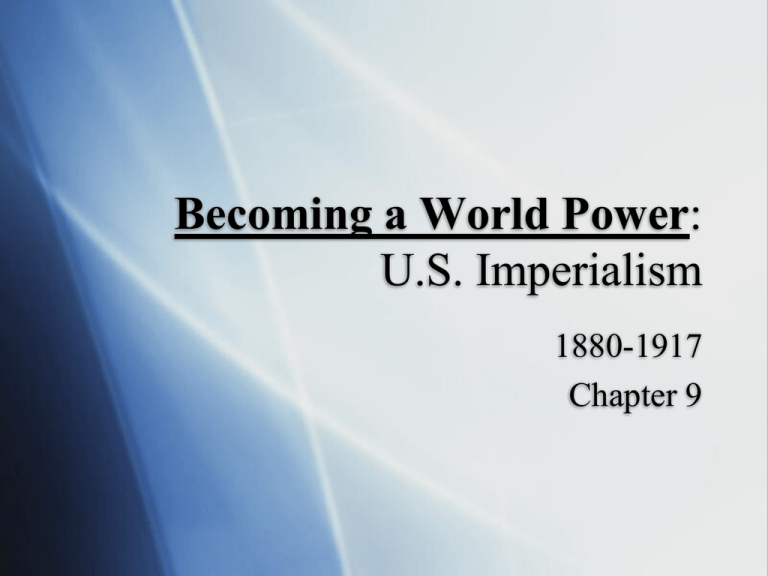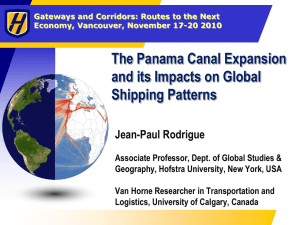Chapter 9, Sec. 1 - Connect Seward County
advertisement

Becoming a World Power: U.S. Imperialism 1880-1917 Chapter 9 Chapter 9, Sec. 1 “The United States Continues to Expand” Reasons to expand for the U.S. included that a) the United States had run out of room and b) other countries in Europe and Japan were doing it as well. Important definitions to add: Annex: to gain control of a country Intervene: to get involved in another country’s affairs, etc. Chapter 9, Sec. 1 “The United States Continues to Expand” Three major reasons the US wanted to expand into other areas of the world: A) Economic reasons: gaining more land would mean more resources to use, and thus make the country more powerful Chapter 9, Sec. 1 “The United States Continues to Expand” Reasons for U.S. Expansion B) military interests: gaining more land would mean more options for military bases and thus more protection Chapter 9, Sec. 1 “The United States Continues to Expand” Reasons for U.S. Expansion C) belief in cultural superiority: many Americans simply felt that they were better than others and that gaining more land would be able to help make others more “American-like” - such as more democracy and spread Christianity Chapter 9, Sec. 1 “The United States Continues to Expand” 1) How and why did we get Alaska? Secretary of State William Seward decided to purchase Alaska from Russia in 1867 for $7.2 million What did people think of Seward’s decision to buy Alaska at that time? People thought it was a huge mistake and made fun of his idea (It ended up being a great move because Alaska had a lot of resources like oil, timber, etc) Chapter 9, Sec. 1 “The United States Continues to Expand” 2) How and why did we get Hawaii? What product was a major money maker in Hawaii by the late 1800s? there were lots of sugar plantations in Hawaii Who did the U.S. gov’t help overthrow in the late 1800s there? we overthrew Queen Liliokalani (& the native Hawaiians) in 1891 What naval base was established in Hawaii? MOVING TO SECTION 2 The Spanish-American War Chapter 9, Sec. 2 “The Spanish American War” People in Cuba and Puerto Rico revolted against what country that was controlling them? Spain Explain how the “yellow journalism” situation in Cuba influenced American thoughts on the situation: Newspapers told exaggerated stories of what Spain was doing to the people there to get the U.S. to get involved (feeding to sharks, etc) This led to American pressure on President McKinley to go to war with Spain Chapter 9, Sec. 2 “The Spanish American War”” This led Pres. McKinley to send the U.S.S. Maine to Cuba. What happened to the U.S.S. Maine and who was blamed for it? The ship blew up and even though they don’t think Spain blew it up, they were blamed for it. See maps next slide of the key areas of the war Chapter 9, Sec. 2 “The Spanish American War”” What set of islands did we attack first when the Spanish-American War started? The Phillipines Explain what happened in the battle of Manila Bay: Thanks to the U.S. iron ships against Spain’s wooden ships, the U.S. overtook Manila Bay in a couple hours Spain surrendered to the U.S. and then the U.S. later annexed the Philippines (even though we told the Filipinos we would let them have their own country during the war) Chapter 9, Sec. 2 “The Spanish American War”” What country did the “Rough Riders” help take over? Cuba Who was the leader of the Rough Riders? Theodore Roosevelt (not President yet) Chapter 9, Sec. 2 “The Spanish-American War” What main countries (all of them islands) did the U.S. get from Spain as a result of the war? USA gained (and annexed) Puerto Rico, Guam and the Philippines For Cuba, we agreed that we got a Naval base there (Guantanamo Bay) Moving to Section 3 China, the Panama Canal, and Latin America President McKinley Assassinated Pres. McKinley Czolgosz What happened to President McKinley in Sept. of 1901? President McKinley was shot in Buffalo, NY. He was shot twice by Leon Czolgosz while shaking hands at an appearance in New York at the PanAmerican Conference. Who took over as President after his death? Vice President Theodore Roosevelt was sworn is as President. Now, on to the building of the Panama Canal… Chapter 9, Sec. 3 “U.S. Involvement Overseas” 3) How/why did we get the land for the Panama Canal? Why was the U.S. interested in building the Panama Canal? The U.S. wanted a connection between the Atlantic and Pacific oceans for easier trade, military movement, etc. What country controlled Panama in the early 1900s? Columbia wouldn’t sell us the canal zone in Panama What did the U.S. do to help rebels in Panama overtake this country’s control? President Roosevelt (now President) sent warships to intimidate Columbia and keep their troops from fighting Chapter 9, Sec. 3 “U.S. Involvement Overseas” What did the new gov’t of Panama sell to the U.S. right away? sold us the canal zone for $10 million Why did the U.S. pay Columbia $25 million in 1921? as an apology for “stealing” the canal zone Chapter 9, Sec. 3 “U.S. Involvement Overseas” 4) Explain how the process went for Youtube construction digging the Panama Canal major challenges that made building the Panama Canal so hard: Swampy land, mosquitos carrying malaria, heat, etc. made working conditions bad Many died while working on the canal and it was much harder than expected 23) Work started in 1904 and was finished in 1914 taking ten years to finish The canal cost $352 million to build by the time it was done! Youtube clip - canal time Chapter 9 Overview The Impact of U.S. Imperialism The U.S. was showing to be a “Big Boy” on the Block. This unit showed that the United States had gotten very powerful in what two major categories for world power: A) The economy was getting stronger and stronger and was now more “global” and involved worldwide B) The U.S. defeat of Spain (in 5 months) showed that the U.S.A. was now a military force to be reckoned with across the world











